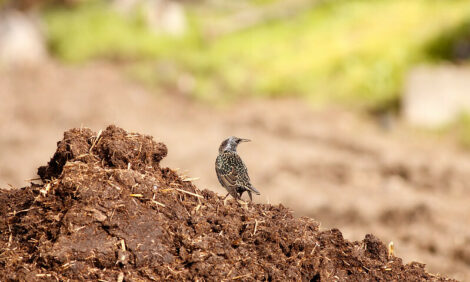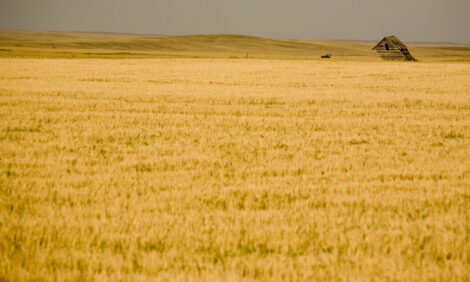



Low Food Price Inflation and Record Meat Output to Combine
US - Lower energy prices, lower transportation costs, the appreciation of the US dollar, drought intensification in the West, and the Farm Bill implementation will affect the agricultural economy in the US over the short term.
Speaking at the USDA Agricultural Outlook Forum last week USDA Chief Economist, Robert C. Johansson said that record global crops for grains and oilseeds have contributed to stock rebuilding, lowering concerns about price volatility, softening export demand, and reducing expected prices for the 2015/16 marketing year.
Lower prices will lead to fewer planted acres, which are forecast down from last year by about 1.3 per cent for the major field crops.
Trend yields and reduced planted acres are expected to lead to 2015 crop production slightly lower than the record levels seen over the last year.
Livestock and dairy producers will continue to benefit from lower feed costs, he said.
And production for livestock, poultry, and dairy all appear to be poised for increases to record levels in 2015.
Total meat and poultry production is forecast to hit a record high of 95 billion pounds in 2015, Mr Johansson said, mostly because of record pork and broiler production.
Milk production is also forecast to be at record levels in 2015, reaching 211.5 billion pounds.
However, increased production and lower expectations for meat and dairy exports contribute to lower expected prices for hogs, broilers, and milk products.
Prospects for expansion in the beef sector have been constrained by the increasingly tight cattle supplies.
The inventory reached a cyclical low on 1 January 2014, with the lowest cattle and calf inventory since 1952.
Mr Johansson said that cattle numbers have been falling since the 1970s, and drought and other adverse impacts on forage in the South over the past five years have driven even larger declines in the cattle herd than might otherwise have been expected.
Drought continues in the Southwest, but there have been some signs of recovery in the Southern Plains and elsewhere
Producers are now responding by increasing herds; the number of beef cows on 1 January 2015 was up two per cent from 2014 and the number of heifers retained for addition to the cow herd was four per cent higher.
In the pig sector, positive producer returns and lower feed costs over much of 2014 have set the stage for strong expansion.
He said that producers have responded to last year’s outbreak of Porcine Epidemic Diarrhoea virus (PEDv) by increasing the weight of slaughter hogs and increasing farrowing intentions.
While incidents of PEDv rise during the winter months, the increase this season has not been as significant as last year, according to the American Association of Swine Veterinarians. As a result, piglets per litter have remained high relative to last year.
US exports continue to be strong for meat and poultry.
Exports in the 2015 financial year are expected to be down slightly from the last year because of the strong US dollar, which has eroded export competitiveness.
However, those exports are projected to grow over the next 10 years.
The forecast for livestock, poultry and dairy product exports is down from the November forecast by nearly $2 billion to $31.8 billion on lower prices and volumes.
Broiler exports remain strong, but down slightly from 2014, a record year, and over the next 10 years, broiler exports are expected to grow by 16 per cent.
Pork exports too are expected to be down from 2014, but are expected to expand 15 per cent over the next decade.
Beef and veal exports are expected to fall slightly in 2015, due to the high beef prices reflecting tight supplies, but are expected to grow by almost 38 per cent over the next 10 years.
Dairy exports, which have shown strong growth over the past five years, are expected to fall slightly in 2015. Over the next 10 years, however, dairy product exports are expected to grow by 34 per cent.
Lower expected prices for crops and livestock also imply a lower forecast for farm incomes.
As the prospect for reduced exports weighs on the dairy market, US prices will fall ahead of increased production. While dairy producers benefit from low feed prices, the expectation for falling product prices at the end of 2014 and into 2015 indicates the margins between feed costs and milk prices, as measured by the Margin Protection Program (MPP), may approach $8 per hundredweight by the spring of 2015.
The implications of agricultural production and commodity prices for food prices, annual food inflation was 2.4 per cent in 2014, below the 20-year average although some food prices increased at a much higher rate in 2014.
Year-over-year beef prices rose by more than 12 per cent last year.
Poultry was the only livestock product category to have product prices rise by less than the average rate of food inflation, increasing by only two per cent last year.
Prices for the other food categories remained about the same last year, except for fruit prices, which increased by almost five percent as a result of drought impacts in California and citrus greening impacts in Florida.
The USDA projects that food inflation will remain in the two per cent to three per cent range for 2015.
Mr Johansson said there would be lower energy prices and lower food prices for cereals, pork, and dairy will offset higher prices for beef, eggs, fruit, and nuts.








